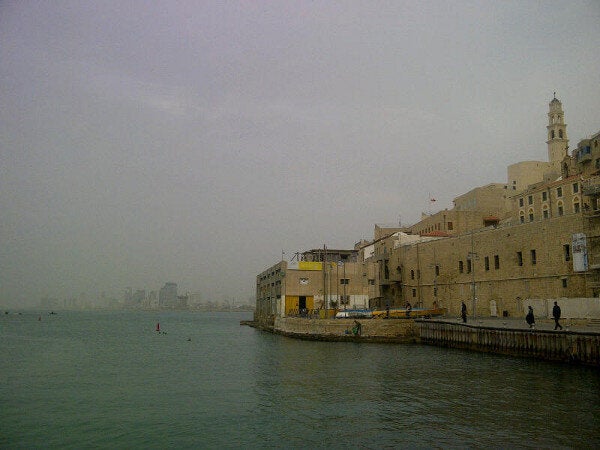
A young Arab fisherman is fixing his nets as my cab pulls into the harbour front. He looks up and then out to sea, shielding his eyes with his hand. 'Benny', my Sephardic cab driver from Lod, south-east of Tel Aviv, drops me off, and not a moment too soon, because he's been singing along to Dire Straits songs for the entire journey.
Following the fisherman's gaze I watch a knotted rope of birds fly in formation, skimming the sea's surface.

This is Jaffa, one of the world's oldest ports, a place thought to have been the port from which Jonah (he of the Whale) departed, but like the whale - whose disappearing tail is only occasionally glimpsed - Israel's socio-political tensions roil out of sight beneath the patina of social cohesion.
To the north, two miles away, lies the friendly cosmopolitan Bauhaus bustle of Tel Aviv; to the south some 40 miles distant, lies Gaza. The ancient city of Jaffa has been caught in a warp of time, with a heterogeneous population of Jews, Christians and Muslims all co-existing in an atmosphere of modulated unease.
Jaffa Hill rises to a height of 130 feet and commands the coastline, with archaeological evidence showing that the city was inhabited 7,500 years BC, its harbour having been in use since the Bronze Age.
Yet despite its antiquity, modern Jaffa is beset by modern troubles: drugs, crime and violence; and suspicion among its civilian population. Some Arab residents allege the Israeli authorities attempt to evict Arab residents from houses owned by the Amidar government-operated housing company.
House prices in Jaffa have risen over the past five years as real estate entrepreneurs have realised the area's potential, given its proximity to Tel Aviv. Residents are suffering from the steep hike, but Arab residents feel as if they are being pushed out with nowhere to go.
Yehudit Ilani, a Jaffa resident, says: 'Two months ago, my rent was raised by NIS 1,000. And every time we move, it's to a smaller place.'
According to Ilani, 700 Jaffa families (both Jewish and Arab) are facing eviction notices, most of them from apartments in Amidar and Halamish public housing projects. 'We are a poor population [...] confronting a real estate monster,' says Ilani.
And beneath the civility experienced at noon on a cool day in March, violence foments. The beating of an Israeli-Arab man, Hassan Ausruf, in February by a gang of youths exposed the hard-to-discern tensions of a Jaffa ostensibly at ease with itself owing to its age and perceived civic wisdom. The city remains a key tourist destination because of its antiquity, and because of the cheek-by-jowl existence of the clergies of the world. Greek and Russian Orthodox churches are represented in Jaffa, as are Armenian Christians, Lutherans and Franciscan Roman Catholics.
Churches rise and loom over the small city, reminding the tourist of the thickened religiosity of the Holy Land; if, indeed, he was in need of reminding. Belief is everywhere, infusing the smallest action with gravitas.

And it was belief that saw the city's port serve as the main entry point to the land of milk and honey until the late 19th century when Jews from around the world began to return to Israel. It was through Jaffa that they entered the country and also settled.
And lest it go unsaid, the place is beautiful, sprawling before the sea like a sleeping woman, the narcotising effect of her suspiration immediate as your eyes grow heavy-lidded at a harbour restaurant. The city must be visited, for to visit Jaffa one can begin to understand a nation whose birth and youth have been difficult. Immoderation lies elsewhere, but in Jaffa life is still being sweetened, even as adversities mount.
But the reverie must end. The rotor thud of a military helicopter splits the sky as it ploughs eastward towards its base. The weight of history is immense, the challenges of the future greater still. For we are in the land of Israel.
© Jason Holmes 2013 / jantholmes@yahoo.co.uk / @JasonAHolmes
Top photograph by JAH
Bottom photograph by George Stavrou / @GStavrouFoto